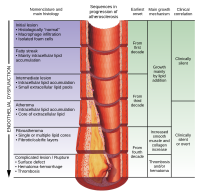
Upregulation of Orai1 and increased calcium entry contribute to angiotensin II-induced human coronary smooth muscle cell proliferation Running Title: Angiotensin II-induced human coronary smooth muscle cells proliferation
Sign Up to like & getrecommendations! Published in 2020 at "Peptides"
DOI: 10.1016/j.peptides.2020.170386
Abstract: Angiotensin II (Ang II) is an oligopeptide of the renin-angiotensin system, and Ang II-induced vascular smooth muscle cell (VSMC) proliferation is an important pathophysiological process involved in atherosclerosis; however, the underlying mechanism remains unclear. Orai1… read more here.
Keywords: induced human; proliferation; smooth muscle; angiotensin ... See more keywords

8-Chloroadenosine induces apoptosis in human coronary artery endothelial cells through the activation of the unfolded protein response
Sign Up to like & getrecommendations! Published in 2019 at "Redox Biology"
DOI: 10.1016/j.redox.2019.101274
Abstract: Infiltration of leukocytes within the vessel at sites of inflammation and the subsequent generation of myeloperoxidase-derived oxidants, including hypochlorous acid, are key characteristics of atherosclerosis. Hypochlorous acid is a potent oxidant that reacts readily with… read more here.
Keywords: unfolded protein; activation unfolded; coronary artery; endothelial cells ... See more keywords

Neuronal nitric oxide synthase-derived hydrogen peroxide effect in grafts used in human coronary bypass surgery.
Sign Up to like & getrecommendations! Published in 2017 at "Clinical science"
DOI: 10.1042/cs20160642
Abstract: Recently, H2O2 has been identified as the endothelium-dependent hyperpolarizing factor (EDHF), which mediates flow-induced dilation in human coronary arteries. Neuronal nitric oxide synthase (nNOS) is expressed in the cardiovascular system and, besides NO, generates H2O2… read more here.
Keywords: bypass; coronary bypass; oxide synthase; nitric oxide ... See more keywords

pH-Dependent Protonation of Histidine Residues Is Critical for Electrostatic Binding of Low-Density Lipoproteins to Human Coronary Arteries
Sign Up to like & getrecommendations! Published in 2022 at "Arteriosclerosis, Thrombosis, and Vascular Biology"
DOI: 10.1161/atvbaha.122.317868
Abstract: Background: The initiating step in atherogenesis is the electrostatic binding of LDL (low-density lipoprotein) to proteoglycan glycosaminoglycans in the arterial intima. However, although proteoglycans are widespread throughout the intima of most coronary artery segments, LDL… read more here.
Keywords: protonation; human coronary; coronary arteries; ldl ... See more keywords

Human Coronary Plaque T Cells Are Clonal and Cross-React to Virus and Self
Sign Up to like & getrecommendations! Published in 2022 at "Circulation Research"
DOI: 10.1161/circresaha.121.320090
Abstract: Background: Coronary artery disease is an incurable, life-threatening disease that was once considered primarily a disorder of lipid deposition. Coronary artery disease is now also characterized by chronic inflammation‚ notable for the buildup of atherosclerotic… read more here.
Keywords: cell; disease; human coronary; plaque cells ... See more keywords

MEF2A alters the proliferation, inflammation-related gene expression profiles and its silencing induces cellular senescence in human coronary endothelial cells
Sign Up to like & getrecommendations! Published in 2019 at "BMC Molecular Biology"
DOI: 10.1186/s12867-019-0125-z
Abstract: BackgroundMyocyte enhancer factor 2A (MEF2A) plays an important role in cell proliferation, differentiation and survival. Functional deletion or mutation in MEF2A predisposes individuals to cardiovascular disease mainly caused by vascular endothelial dysfunction. However, the effect… read more here.
Keywords: mef2a; senescence; inflammation; expression ... See more keywords

Allometric scaling patterns among the human coronary artery tree, myocardial mass, and coronary artery flow
Sign Up to like & getrecommendations! Published in 2020 at "Physiological Reports"
DOI: 10.14814/phy2.14514
Abstract: Human coronary artery tree is a physiological transport system for oxygen and vital materials through a hierarchical vascular network to match the energy demands of myocardium, which has the highest oxygen extraction ratio among body… read more here.
Keywords: artery tree; artery; allometric scaling; coronary artery ... See more keywords

Transcription factor GATA1 represses oxidized-low density lipoprotein-induced pyroptosis of human coronary artery endothelial cells.
Sign Up to like & getrecommendations! Published in 2022 at "Clinical hemorheology and microcirculation"
DOI: 10.3233/ch-221536
Abstract: BACKGROUND Atherosclerosis (AS) is defined as a chronic inflammatory disorder underly the pathogenesis of cardiovascular diseases (CVDs). Endothelial pyroptosis is associated with AS-like diseases and other CVDs. OBJECTIVE This work was designed to expound on… read more here.
Keywords: ror; transcription; pyroptosis; pyroptosis human ... See more keywords

Increased atherosclerotic plaque in AOC3 knock-out in ApoE−/− mice and characterization of AOC3 in atherosclerotic human coronary arteries
Sign Up to like & getrecommendations! Published in 2022 at "Frontiers in Cardiovascular Medicine"
DOI: 10.3389/fcvm.2022.848680
Abstract: Introduction Amine oxidase copper containing 3 (AOC3) displays adhesion between leukocytes and endothelial cells and enzymatic functions. Given its controversial role in atherogenesis, we proposed to investigate the involvement of AOC3 in the formation of… read more here.
Keywords: increased atherosclerotic; aoc3; human coronary; coronary arteries ... See more keywords

Pequi Fruit Extract Increases Antioxidant Enzymes and Reduces Oxidants in Human Coronary Artery Endothelial Cells
Sign Up to like & getrecommendations! Published in 2022 at "Antioxidants"
DOI: 10.3390/antiox11030474
Abstract: Reactive oxygen species (ROS) imbalance results in endothelial cell function impairment. Natural phenolic antioxidant compounds have been investigated as therapeutic alternatives. The fruit bark of Brazilian-native pequi (Caryocar brasiliense, Camb.) is rich in polyphenols. The… read more here.
Keywords: coronary artery; extract; human coronary; artery endothelial ... See more keywords

Low Effectiveness of the Introduction of pmaxGFP into Primary Human Coronary Endothelial Cells Using Cell-Penetrating Peptides and Nuclear-Localization Sequences in Non-Covalent Interactions
Sign Up to like & getrecommendations! Published in 2021 at "Applied Sciences"
DOI: 10.3390/app11051997
Abstract: Cell-penetrating peptides (CPPs), due to their effectiveness and low cytotoxicity, are of increasing interest in the context of the transport of macromolecules to the cells. The simplest and safest method seems to be the non-covalent… read more here.
Keywords: human coronary; cell penetrating; non covalent; penetrating peptides ... See more keywords